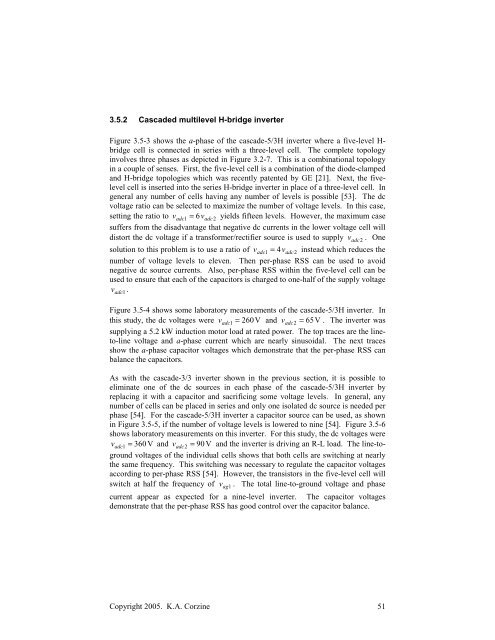Operation and Design of Multilevel Inverters Dr ... - MotorLab.com
Operation and Design of Multilevel Inverters Dr ... - MotorLab.com
Operation and Design of Multilevel Inverters Dr ... - MotorLab.com
You also want an ePaper? Increase the reach of your titles
YUMPU automatically turns print PDFs into web optimized ePapers that Google loves.
3.5.2 Cascaded multilevel H-bridge inverter<br />
Figure 3.5-3 shows the a-phase <strong>of</strong> the cascade-5/3H inverter where a five-level Hbridge<br />
cell is connected in series with a three-level cell. The <strong>com</strong>plete topology<br />
involves three phases as depicted in Figure 3.2-7. This is a <strong>com</strong>binational topology<br />
in a couple <strong>of</strong> senses. First, the five-level cell is a <strong>com</strong>bination <strong>of</strong> the diode-clamped<br />
<strong>and</strong> H-bridge topologies which was recently patented by GE [21]. Next, the fivelevel<br />
cell is inserted into the series H-bridge inverter in place <strong>of</strong> a three-level cell. In<br />
general any number <strong>of</strong> cells having any number <strong>of</strong> levels is possible [53]. The dc<br />
voltage ratio can be selected to maximize the number <strong>of</strong> voltage levels. In this case,<br />
setting the ratio to v adc1<br />
= 6vadc2 yields fifteen levels. However, the maximum case<br />
suffers from the disadvantage that negative dc currents in the lower voltage cell will<br />
distort the dc voltage if a transformer/rectifier source is used to supply v adc2<br />
. One<br />
solution to this problem is to use a ratio <strong>of</strong> v adc1<br />
= 4vadc2 instead which reduces the<br />
number <strong>of</strong> voltage levels to eleven. Then per-phase RSS can be used to avoid<br />
negative dc source currents. Also, per-phase RSS within the five-level cell can be<br />
used to ensure that each <strong>of</strong> the capacitors is charged to one-half <strong>of</strong> the supply voltage<br />
v .<br />
adc1<br />
Figure 3.5-4 shows some laboratory measurements <strong>of</strong> the cascade-5/3H inverter. In<br />
this study, the dc voltages were 1 260V<br />
= v adc <strong>and</strong> 2 65V<br />
= v adc . The inverter was<br />
supplying a 5.2 kW induction motor load at rated power. The top traces are the lineto-line<br />
voltage <strong>and</strong> a-phase current which are nearly sinusoidal. The next traces<br />
show the a-phase capacitor voltages which demonstrate that the per-phase RSS can<br />
balance the capacitors.<br />
As with the cascade-3/3 inverter shown in the previous section, it is possible to<br />
eliminate one <strong>of</strong> the dc sources in each phase <strong>of</strong> the cascade-5/3H inverter by<br />
replacing it with a capacitor <strong>and</strong> sacrificing some voltage levels. In general, any<br />
number <strong>of</strong> cells can be placed in series <strong>and</strong> only one isolated dc source is needed per<br />
phase [54]. For the cascade-5/3H inverter a capacitor source can be used, as shown<br />
in Figure 3.5-5, if the number <strong>of</strong> voltage levels is lowered to nine [54]. Figure 3.5-6<br />
shows laboratory measurements on this inverter. For this study, the dc voltages were<br />
1 360V<br />
= v adc <strong>and</strong> 2 90V<br />
= v adc <strong>and</strong> the inverter is driving an R-L load. The line-toground<br />
voltages <strong>of</strong> the individual cells shows that both cells are switching at nearly<br />
the same frequency. This switching was necessary to regulate the capacitor voltages<br />
according to per-phase RSS [54]. However, the transistors in the five-level cell will<br />
switch at half the frequency <strong>of</strong> v ag1<br />
. The total line-to-ground voltage <strong>and</strong> phase<br />
current appear as expected for a nine-level inverter. The capacitor voltages<br />
demonstrate that the per-phase RSS has good control over the capacitor balance.<br />
Copyright 2005. K.A. Corzine 51


